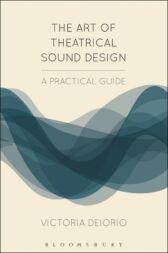Synopsis
The Art of Theatrical Sound Design - A Practical Guide
Published by Methuen
Through tried-and-tested advice and lessons in practical application, this seminal Guide allows developing artists to apply psychology, physiology, sociology, anthropology and all aspects of sound phenomenology to theatrical sound design.
Structured in Three Parts, the book explores:
How human beings perceive the vibration of sound
How to develop support for storytelling by creating an emotional journey for the audience
How to collaborate and communicate as a theatre artist
And how to create a cohesive sound design for the stage
TABLE OF CONTENTS
Introduction
Who am I?
Why life choices matter
How this book can help you
PART ONE - THEORETIC FOUNDATION
Sound and Human Perception
Humans as artists
Aesthetic response
Mindbody connection
Biology, physics, and psychology
Perception
Describing sound
Describing music
Theatre artists
THE ART OF SPACIAL DESIGN
Space and place
Four aspects to auditory spatial awareness
The architects
Auditory subcultures
Cultural value of acoustic context
Nature of cultural silence
Aural texture
Soundmarks
Subspaces
THE THEATRE SPACE
The theater space
Practical application
Temporal and spatial spreading
Reverberation
Part 1 Exercises
PART TWO - CONTEXTUAL APPLICATION AND EXERCISES
Exercises to Develop Artistic Sound Design Skills
Moving forward
Themes
Repetition
Punctuation
Dynamics
Ambience
Drones
Time
Concrete vs Abstract
HISTORY EXERCISES USING TOOLS
Music in the 1600s
Music in the 1700s
Music in the 1800s
Music 19001920
Music 19201940
Music 19401960
Music 19601980
Music 19802000
Music 20002010
PART THREE - THE COLLABORATIVE PROCESS
Applying Tools and Artistic Collaboration
Working with text
Theatrical application
COLLABORATIVE PROCESS OF A SOUND DESIGNER
Intellectual interpretation
Design and production meetings
Rehearsals
Quiet time and level set
The first moment sound is heard
Tech
Objective and subjective listening
Previews
Ownership
COHESION, CONVENTION, AN IMPLEMENTATION
Cohesion
Convention
Cohesion in the tech process
Cohesion with voice and movement
Cohesion with your collaborators
COMMUNICATION FOR THE ARTISTIC PROCESS
Group dynamics
Behavior and attitude
Motivation and self-empowerment = Assertiveness
Self-awareness skills
Self-talk
Taking self-responsibility
Feedback
The digital age-the first introduction
Communication in the digital age-email etiquette
Interpreting visual representation
Cooperation vs. collaboration
Communication
Conclusion
Bibliography
Glossary
REVIEWS
"This fascinating book is informed by the author's wide range of experience, from performer in dance, music and acting to sound designer and director. Beginning with the physiology and psychology of human hearing, the book takes an eclectic path to an examination of successful artistic collaboration, through developmental and intellectual exercises, the study of cultural and historical influences and, ultimately, the reality of applying the lessons learned in a professional environment. As a rigorous and in-depth study of the art of sound design for theatre, it should become an invaluable asset to any serious student of this often under-appreciated and under-explored art" ~ John Leonard, theatre and exhibition sound designer and the author of Theatre Sound
"[DeIorio] has artfully engaged the reader in the understanding of perception and meaning, acoustical context, design and intention, the breadth of musical expression, the conveyance of emotional values, an historical perspective on music, the designer's tools that can affect audience responses, and some valuable insight on collaboration between members of the artistic team... This book is important for anyone considering a creative career in the diverse world of Professional Sound Design. I heartily recommend it" ~ David Budries, Professor in the Practice of Sound Design Chair, Department of Sound Design, Yale School of Drama
 $27.99
$27.99